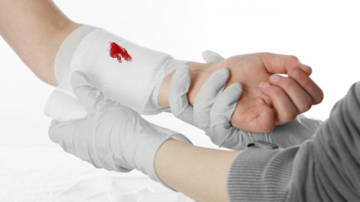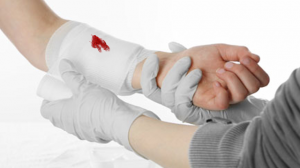External Bleeding Tips
1. Do not waste precious seconds by attempting to open and apply dressings at this stage.
2. With your gloved hand apply external direct pressure to the wound.
3. If a foreign object is present, you will have to apply pressure around the object.
4. If appropriate, allow the casualty to apply external direct pressure with their free hands.
5. If you have not done so already, ensure your casualty is sitting or lying down.
4) Elevation
1. Whenever possible, the injured body part should be raised, if there are no
2. Ideally, elevation particularly with regard to limbs should be above the heart.
3. If dealing with the legs, the casualty should lie down with both legs elevated.
4. The elevated limb may require support.
5) Dressing
1. Select a suitable sterile dressing from your first aid box.
2. If the dressing is applied to a limb, check the circulation to the hand or foot to ensure the dressing has not been tied too tightly.
3. Apply a dressing directly to the wound and bandage it firmly in place.
4. Whilst keeping the injury elevated watch for any signs of blood seeping through the dressing.
5. If blood seeps through the dressing apply a 2nd dressing on top of the first dressing. If blood seeps through the second dressing, remove both and apply a new dressing.
6. If there is a foreign object in the wound leave it in place and build the dressing around the object. Do not apply pressure directly. Call 999 for major bleeds.
NB – Do not use a tourniquet to prevent blood loss.
6) Blood and Body Fluid Clean-Up
The following precautions should be carried out at all times where a first aider comes into contact with blood or bodily fluids:
1. Intact skin is a good barrier to infection, however the first aider should make sure all cuts or open areas are covered.
2. If you have accidentally come into contact with blood wash the area with soap and water, seek medical advice.
3. If blood has splashed in your eyes or in an open wound / needle stick injury / punctured skin rinse thoroughly with water or eyewash, seek medical advice.
4. Should you have any concerns discuss these with your Doctor or Occupational Health Department.
The information contained is for guidance only and should not be used as a substitute for recognized training.



